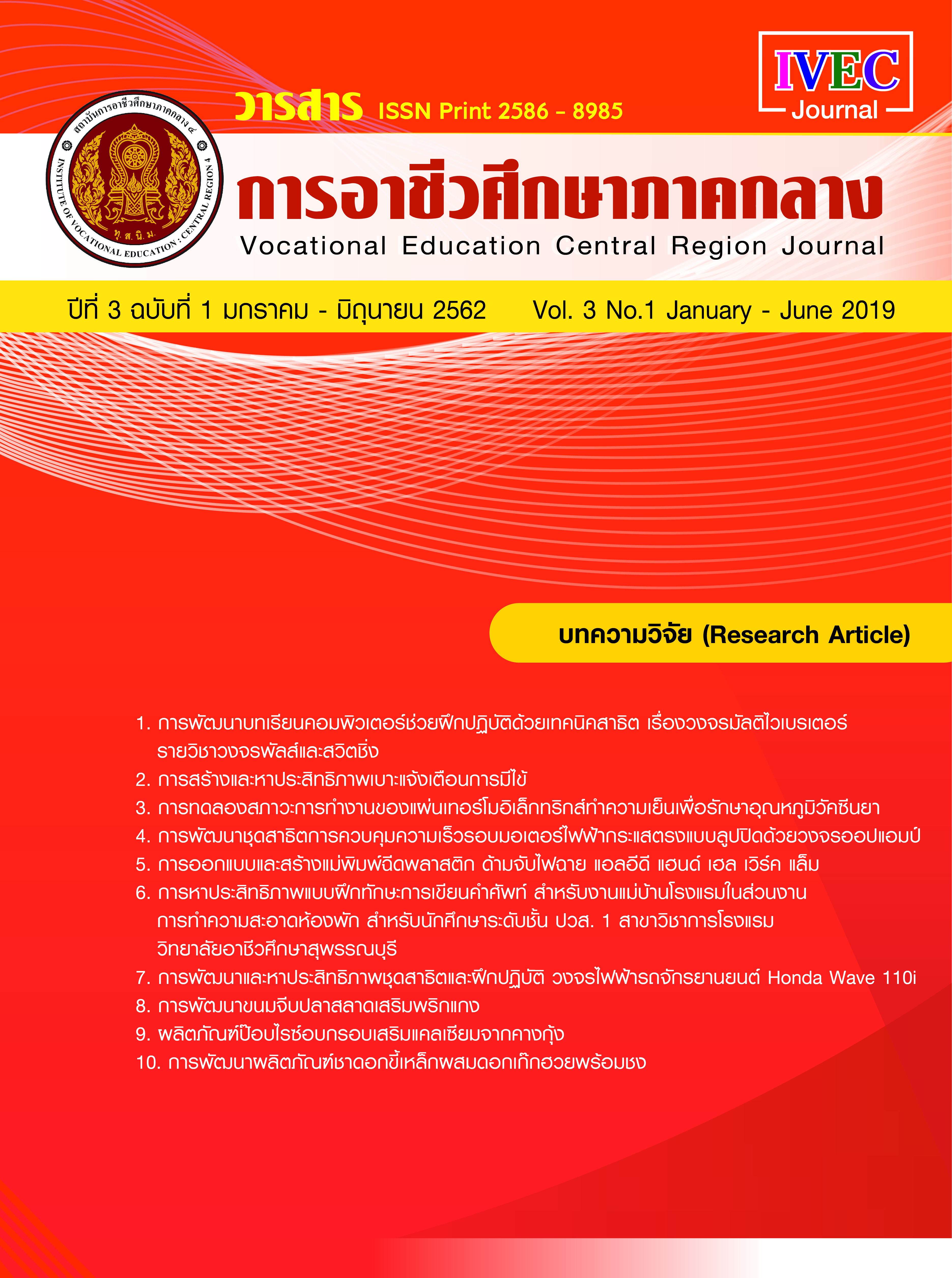Snack Food from Popped Rice with Calcium from Shrimp Chin
Main Article Content
Abstract
The objectives of this study were to: 1) study the sensory accepted of snack food from popped Rice with calcium from Shrimp chin with different quantity of shrimp chin and 2) calculate nutrition value of calcium from popped rice in shrimp chin food at the different quantity 0%, 20%, 40%, and 60% (weight of total popped rice 100 grams).
The research findings presented that: 1) standard formula consist of Pop Rice 38.03 %, sugar 19.01 %, butter 19.01 %, water 15.21 %, glucose syrup 7.60 % , and salt 1.14 %. The sensory evaluation of snack food from popped rice with calcium from shrimp chin was founded 60% gained scores in appearanced, color, odor, taste, crispy, and total value increased are 7.95, 7.95, 8.65, 8.35, 7.90 and 8.40, respectively and 2) calculated in value of nutrition of snack food from popped rice with calcium from shrimp chin founded the formula 60 % taken energy 1,002.28 kilocalories carbohydrate 137.12 grams protien 14.38 grams fat 45.94 grams and calcium 2,640.89 milligrams, respectively.
Article Details
|
บทความ ข้อมูล เนื้อหา รูปภาพ ฯลฯ ที่ได้รับการตีพิมพ์ในวารสาร การอาชีวศึกษาภาคกลาง ถือเป็นลิขสิทธิ์ของวารสารการอาชีวศึกษาภาคกลางหากบุคคลหรือหน่วยงานใดต้องการนำทั้งหมดหรือส่วนใดส่วนหนึ่ง ไปเผยแพร่ต่อหรือเพื่อกระทำการใด ๆ กองบรรณาธิการไม่สงวนสิทธิ์ ในการคัดลอกบทความเพื่อการศึกษาแต่ให้อ้างอิงแหล่งที่มาให้ครบถ้วน สมบูรณ์ สงวนสิทธิ์ โดย สถาบันการอาชีวศึกษาภาคกลาง 4 ที่ตั้ง 90 ถนนเทศา ตำบลพระปฐมเจดีย์ อำเภอเมือง จังหวัดนครปฐม โทรศัพท์ 034 242 856 , โทรสาร 034 242 858 ISSN : 3056-9176 (print) ISSN : 2985-2382 (online) |
References
2. กระปุก. แคลเซียมความต้องการของคนต่างวัย. (2553). ค้นเมื่อ ตุลาคม 7, 2561, จาก : https://health.kapook.com/ view17837.html
3. เจนจิรา บัวทอง. (2561). ขนมกรุบกรอบภัยเงียบทำร้ายสุขภาพ. ค้นเมื่อ ตุลาคม 10, 2561, จาก : https://www.pstip.com/b/อาหารเพื่อสุขภาพ/ขนมกรุบกรอบภัยเงียบทำร้ายสุขภาพ.html
4. ชุติมณฑภรณ์ ทัมทิมเขียว และนัฐนันท์ ทวีรัตน์ธนนท์. (2551). ขนมขบเคี้ยวจากปลา. รายงานการวิจัย มหาวิทยาลัยเทคโนโลยีราชมงคลกรุงเทพฯ.
5. ศรายุทธ เกษมสุข และฐิติวดี รวงในเมือง. (2548). การพัฒนาผลิตภัณฑ์ขนมกรอบจากข้าวตอก. ภาคนิพนธ์ปริญญาบัณฑิต คณะวิทยาศาสตร์และเทคโนโลยี มหาวิทยาลัยราชภัฏนครราชสีมา.
6. ศศิธร อินทผลสุขและพิทักษ์ ศิริวงศ์. (2559). โอกาสทางการตลาดของผลิตภัณฑ์คางกุ้งทอดกรอบ โอคุส โน่. ใน การประชุมวิชาการเสนอผลงานวิจัยระดับชาติ วิทยาลัยเทคโนโลยีพนมวันท์ ครั้งที่ 1 “การวิจัยเพื่อการพัฒนา เผยแพร่ และถ่ายทอดเทคโนโลยีที่ทันสมัยต่อสังคม” (16-17 กรกฎาคม, หน้า 1584-1595 ). นครราชสีมา: วิทยาลัยเทคโนโลยีพนมวันท์
7. ศูนย์เครือข่ายข้อมูลอาหารครบวงจร. (2555). คุณภาพและมาตรฐานอาหาร วิธีการกำหนดปริมาณอาหารหนึ่งหน่วย. ค้นเมื่อ ตุลาคม 7, 2561, จากhttp://www.foodnetworksolution.com /news_and_articles/article/0068 /วิธีการกำหนดปริมาณอาหารหนึ่งหน่วยบริโภค
8. สกุลไทย และเว็บไซด์คมไผ่. (2556). ข้าวตอก ความหมายของข้าวตอก. ค้นเมื่อ ตุลาคม 10, 2561, จาก https://guru.sanook.com/6004/
9. อรุณี เจตศรีสุภาพ. (2561). ปัญหาโภชนาการในเด็ก : การขาดโปรตีนและกำลังงานสารอาหาร. ค้นเมื่อ ตุลาคม 10, 2561, จาก www.haamor.com/th
10. เอมอร ตรีภิญโญยศ. (2560). 100 เมนู เสี่ยงโรคภัยที่คุณควรระวัง. กรุงเทพฯ: ไพลิน.
11. Chambers, E. IV. and M.B. Wolf. (1996). Sensory Testing Methods. (2nd ed). West Conshohocken: ASTM
12. Khan, M. and Nowsad, A. (2013). Development of protein enriched shrimp crackers from shrimpshell wasters. Bangladesh Agricultural University, 10, (2), pp. 367-374.
13. Ning Yan and Xi Chen. (2015). Don’t waste seafood waste. Science, 524, (7564), pp. 155-157
14. Sarah M. Phillips, Linda G. Bandini, Elena N. Naumova, Helene Crye Colclough, Willam H. Dietz and Aviva Must. (2012). Energy-Dense Snack Food Intake in Adolescence: Longitudinal Relationship to Weight and Fatness. Obesity Research, 12, pp. 461-472.


